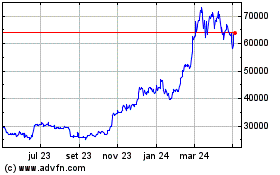Ether Liquidity Plummets 40% On Exchanges After ETF Debut
07 Setembro 2024 - 11:30PM
NEWSBTC
Liquidity of Ether on US exchanges has plunged as much as 40% since
the first spot Ether exchange-traded funds entered the market on
July 23, 2024. Related Reading: Cardano Bull Sees ADA Jumping
1,000% In An ‘Insane’ Rally That is a move rather expectedly coming
for traders and analysts that had previously viewed the ETFs as a
means to improve market liquidity and therefore stabilize prices.
Instead, what has taken place is rather different: the average
market depth of 5% for ETH pairs has fallen to around $14 million.
Meanwhile, offshore exchanges are posting a similar decline at
about $10 million in liquidity. Ether Liquidity Down Following the
launch of nine ETFs in July, Ether’s liquidity plummeted 20% on US
markets and 19% on offshore locations. The decline in liquidity is
one thing that raises concerns and, more importantly, it signals
greater sensitivity to large orders. With shallow market depth, it
follows that even minor trades can result in dramatic changes in
prices. Jacob Joseph, a research analyst at CCData, said that
liquidity is still better than at the beginning of the year but has
really dropped almost 45% since its peak in June. Poor market
conditions and seasonal effects are mainly responsible as summer
months will have fewer trading activities. Market Dynamics And ETF
Performance Their introduction was expected to increase liquidity,
much as it had done in the case of the Bitcoin ETFs introduced
earlier this year. However, the Ether market hasn’t responded as
well. In the period since their introduction, Ether ETFs have
suffered from over $500 million in cumulative outflows. That has
contributed to a general decline in liquidity, making markets even
more volatile. Surprisingly, ETFs have had their own performances.
For instance, Grayscale’s ETHE ETF witnessed an outflow as high as
$10.7 million, while BlackRock’s ETHA ETF saw an inflow as low as
$4.7 million. Such mixed results hint that Ether markets are yet to
come out of their troubled times, with investments reflecting
investors’ reluctance to commit capital in unsure times. Related
Reading: Aptos (APT) Dips 15% As New Innovations Fail To Spark
Momentum Implications For Traders And Investors A drop in liquidity
is a challenge for traders and investors alike, actually. In states
of low liquidity, the slippage is much higher, and the price for
the execution is costlier. The big problem lies in the fact that
the institutional investors like their markets stable and with good
liquidity. If these large players stop full operations, that could
create some kind of vicious cycle when the liquidity will be even
lower and prices go further down. For now, Ether trades hands at
about $2,258, down over 4% in the past 24 hours. The wider
cryptocurrency market is also under stress: All major altcoins,
including Solana and Ripple, are in the red, posting losses in a
range between 2% to 4%. Going forward, market participants will be
in a position where expected benefits of the ETF introductions have
not materialized for Ether. With potential interest rate cuts by
the Federal Reserve, market attention in the future might shift to
how these changes are going to affect liquidity and trading
activity in the months ahead. Featured image from Getty Images,
chart from TradingView
Bitcoin (COIN:BTCUSD)
Gráfico Histórico do Ativo
De Ago 2024 até Set 2024

Bitcoin (COIN:BTCUSD)
Gráfico Histórico do Ativo
De Set 2023 até Set 2024
